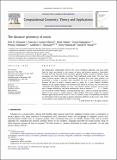| dc.contributor.author | Demaine, Erik D. | |
| dc.contributor.author | Gomez-Martin, Francisco | |
| dc.contributor.author | Meijer, Henk | |
| dc.contributor.author | Rappaport, David | |
| dc.contributor.author | Taslakian, Perouz | |
| dc.contributor.author | Winograd, Terry | |
| dc.contributor.author | Wood, David R. | |
| dc.contributor.author | Toussaint, Godfried | |
| dc.date.accessioned | 2015-03-25T14:35:21Z | |
| dc.date.available | 2015-03-25T14:35:21Z | |
| dc.date.issued | 2008-12 | |
| dc.date.submitted | 2008-04 | |
| dc.identifier.issn | 09257721 | |
| dc.identifier.uri | http://hdl.handle.net/1721.1/96166 | |
| dc.description.abstract | We demonstrate relationships between the classic Euclidean algorithm and many other fields of study, particularly in the context of music and distance geometry. Specifically, we show how the structure of the Euclidean algorithm defines a family of rhythms which encompass over forty timelines (ostinatos) from traditional world music. We prove that these Euclidean rhythms have the mathematical property that their onset patterns are distributed as evenly as possible: they maximize the sum of the Euclidean distances between all pairs of onsets, viewing onsets as points on a circle. Indeed, Euclidean rhythms are the unique rhythms that maximize this notion of evenness. We also show that essentially all Euclidean rhythms are deep : each distinct distance between onsets occurs with a unique multiplicity, and these multiplicities form an interval 1,2,…,k−11,2,…,k−1. Finally, we characterize all deep rhythms, showing that they form a subclass of generated rhythms, which in turn proves a useful property called shelling. All of our results for musical rhythms apply equally well to musical scales. In addition, many of the problems we explore are interesting in their own right as distance geometry problems on the circle; some of the same problems were explored by Erdős in the plane. | en_US |
| dc.description.sponsorship | Natural Sciences and Engineering Research Council of Canada | en_US |
| dc.description.sponsorship | Fonds québécois de la recherche sur la nature et les technologies | en_US |
| dc.language.iso | en_US | |
| dc.publisher | Elsevier | en_US |
| dc.relation.isversionof | http://dx.doi.org/10.1016/j.comgeo.2008.04.005 | en_US |
| dc.rights | Article is made available in accordance with the publisher's policy and may be subject to US copyright law. Please refer to the publisher's site for terms of use. | en_US |
| dc.source | Elsevier | en_US |
| dc.title | The distance geometry of music | en_US |
| dc.type | Article | en_US |
| dc.identifier.citation | Demaine, Erik D., Francisco Gomez-Martin, Henk Meijer, David Rappaport, Perouz Taslakian, Godfried T. Toussaint, Terry Winograd, and David R. Wood. “The Distance Geometry of Music.” Computational Geometry 42, no. 5 (July 2009): 429–454. © 2009 Elsevier B.V. | en_US |
| dc.contributor.department | Massachusetts Institute of Technology. Computer Science and Artificial Intelligence Laboratory | en_US |
| dc.contributor.department | Massachusetts Institute of Technology. Department of Electrical Engineering and Computer Science | en_US |
| dc.contributor.mitauthor | Demaine, Erik D. | en_US |
| dc.contributor.mitauthor | Toussaint, Godfried | en_US |
| dc.relation.journal | Computational Geometry | en_US |
| dc.eprint.version | Final published version | en_US |
| dc.type.uri | http://purl.org/eprint/type/JournalArticle | en_US |
| eprint.status | http://purl.org/eprint/status/PeerReviewed | en_US |
| dspace.orderedauthors | Demaine, Erik D.; Gomez-Martin, Francisco; Meijer, Henk; Rappaport, David; Taslakian, Perouz; Toussaint, Godfried T.; Winograd, Terry; Wood, David R. | en_US |
| dc.identifier.orcid | https://orcid.org/0000-0003-3803-5703 | |
| mit.license | PUBLISHER_POLICY | en_US |
| mit.metadata.status | Complete | |
